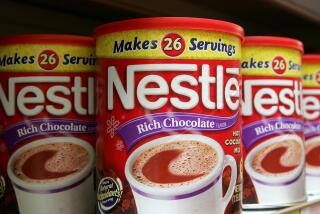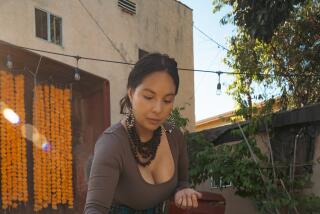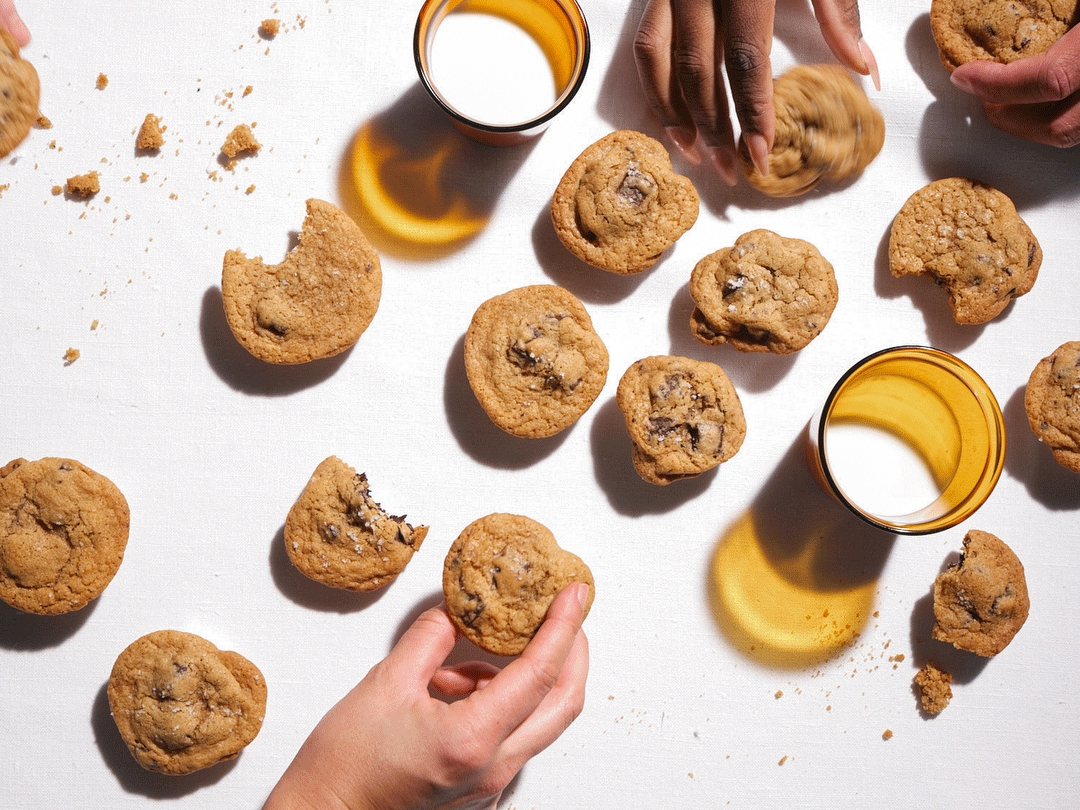A bittersweet love affair
- Share via
As soon as we turned the corner onto La Rambla, Barcelona’s famed pedestrian street, I was ready to sit down at the first outdoor table and order that hot chocolate. The one I had yet to taste. The one that was out of this world. The one my half-Spanish husband kept telling me about all these years. But my husband kept walking, leading me down the restaurant-lined boulevard teeming with street performers, souvenir sellers, awestruck tourists and enterprising pickpockets.
“We can’t have it just anywhere,” he said. “Not in a tourist trap.” So we passed cafe after cafe that morning, me jealously peeking into the cups of patrons seated on the patios, him on the lookout for the right kind of place.
At last, we ducked down a side alley and, soon after, into a dark room. It was a narrow space, with a bar on one side of the tiled floor and a line of wooden tables and chairs on the other. It was cool and quiet, a refuge from the circus just a few yards outside. A couple of locals at the bar looked over and nodded at us.
“Are you sure they’ll have hot chocolate?” I whispered. My husband shot me a look, then smiled as he ordered without looking at the menu. When our drinks arrived, I felt like a kid. Hot chocolate for breakfast!
But as soon as I tasted it, I felt deliciously grown-up. This was no baby’s chocolate milk. This was the thinking chocoholic’s brew. The concoction, so very dark in its snow-white cup, was as thick as pudding but eminently drinkable. It was rich and creamy, but not unctuously so. Its sweetness was in service of the chocolate, not in competition with it; bitter cacao notes and a complex flavor engaged the palate. On the little saucer underneath was a loop of fried dough, the Spanish churro, for dunking. Nice, but when you have hot chocolate this good, anything else is just a bonus.
It was the Spanish, in fact, who were first responsible for putting the milk in hot chocolate. The first chocolate drinks, in the days of the Aztecs, were no more than ground cocoa beans and water -- sort of the chocolate equivalent of black coffee.
Adding milk and sugar became the norm after the Spaniards arrived in Mexico and helped popularize hot chocolate around Europe. What’s now known as Mexican hot chocolate is sweet and creamy, with its signature hint of cinnamon. And recently Starbucks borrowed the name of an Aztec domestic goddess, Chantico, for its new very dark hot chocolate, though not her recipe.
That first spartan blend does remind us, though, that it’s the flavor of the roasted cacao bean that’s at the heart of hot chocolate’s appeal. Truly adult versions combine bitter, sweet and creamy notes in perfect balance so the true chocolate flavor comes through. These days, with so many premium-quality high-cacao-content chocolate bars and cocoa powders now on the market, it’s easy to make extraordinary hot chocolate at home.
The first step is to choose your chocolate judiciously.
That’s just the premise behind the recipe I adapted from one in Dorie Greenspan’s “Paris Sweets” cookbook. I took her advice, choosing a candy bar I love straight out of the wrapper, and the recipe delivered me to the same bittersweet heaven. Then I couldn’t resist but play with numbers, trying chocolate bars marked with different percentages of cacao.
The results were interesting with bars in the 50% to 60% range, but when I tried making a batch with Valrhona’s 71% cacao, the intensity was fabulous and the recipe’s four servings miraculously stretched to eight. It was, as a friend put it, the espresso of hot chocolate -- so incredibly dark that a little bit went a long way.
When chopping the chocolate, work lightly, handling it as little as possible to avoid a melting mess. And if you have one, use a serrated knife, which makes it easier to chop finely; it’s also less likely than a regular blade to slip on the chocolate’s smooth surface.
Whatever candy bar you choose, don’t skip this recipe’s final step, which calls for frothing with an immersion wand or a whirring in the blender. Greenspan says this is the secret to smoothness. But frothing offers other pluses. One is that it prevents a “skin” from forming on the surface. The other is the cappuccino-like foam that blending creates. After pouring the hot chocolate into cups, spoon out the remaining froth in the blender jar and top each serving with a luxurious chocolate cloud.
Frothing is a European contribution to hot chocolate. Even some versions of Spanish hot chocolate involve repeated whisking, but I liked the chocolate-pudding approach used by Janet Mendel, in her book “My Kitchen in Spain.” Her recipe uses milk, but she writes that Spaniards sometimes use water instead for an even darker drink.
Our third recipe is an update of an everyday hot cocoa. It’s made with a combination of milk and half-and-half for richness, but the real secret is in the quality of the cocoa powder. For a hot cocoa with a deep and rich flavor, look for Dutch-processed cocoa.
You’ll get fine results with a common brand such as Droste, but Valrhona’s exceptional cocoa powder is out of this world. With it, hot cocoa is beyond grown-up. It’s darkly divine, transcending all the merely mortal cocoas out there.
**
Spanish hot chocolate (chocolate a la taza)
Total time: 20 minutes
Servings: 4 to 5
Note: Adapted from Janet Mendel’s “My Kitchen in Spain.” Use a high-quality chocolate bar such as Scharffen Berger semisweet, 62% cacao.
3 cups water, divided
3 tablespoons cornstarch
8 ounces semisweet chocolate chips or semisweet chocolate bars broken into 1/4 -inch pieces
2 cups milk
1/4 cup sugar, or more to taste
1/2 teaspoon vanilla extract
1. In a small bowl, mix 1 cup of water with the cornstarch. Set aside.
2. Pour the remaining 2 cups of water into a medium saucepan. Add the chocolate, and cook over medium-high heat, stirring until the chocolate is melted and smooth.
3. Mix in the milk and sugar. Give the cornstarch mixture a quick stir and add it to the saucepan. Cook over medium heat, stirring constantly, or until the mixture begins to coat the back of a spoon, about 5 to 8 minutes. (The hot chocolate will continue to thicken even after cooking to the desired pudding-like consistency.)
4. Remove from the heat and stir in the vanilla. Add more sugar if desired. Serve immediately.
Each serving: 418 calories; 6 grams protein; 59 grams carbohydrates; 3 grams fiber; 21 grams fat; 12 grams saturated fat; 12 mg. cholesterol; 56 mg. sodium.
**
Parisian-style hot chocolate
Total time: 15 minutes
Servings: 4
Note: Adapted from “Paris Sweets” by Dorie Greenspan. Greenspan calls for bittersweet chocolate, but it’s also delicious made with a dark chocolate such as Valrhona Le Noir 61% cacao. If not you’re not serving it immediately, refrigerate for up to 2 days in a covered container, then heat, blend and serve.
3 cups milk
1/3 cup water
1/3 cup sugar
6 ounces bittersweet or dark chocolate, finely chopped
1. Place the milk, water and sugar in a medium saucepan. Over medium-high heat, bring the mixture to a boil. Remove the pan from the heat, add the chocolate and whisk until the chocolate is melted.
2. Using an immersion blender, whip the hot chocolate in the saucepan for 1 minute. If you don’t have an immersion blender, pour half the mixture into a blender, cover, then cover the top of the blender with a towel, holding down the lid, and whip on high speed for 1 minute. Repeat with the remaining chocolate mixture. Serve immediately. Makes about 4 cups.
Each serving: 412 calories; 9 grams protein; 49 grams carbohydrates; 1 gram fiber; 21 grams fat; 3 grams saturated fat; 18 mg. cholesterol; 73 mg. sodium.
**
Hot cocoa
Total time: 10 minutes
Servings: 4
Note: You can make a milk-chocolate or dark-chocolate drink using the same ingredients just by varying the proportions. The first set of measurements is for a milk-chocolate cocoa. To make a dark-chocolate cocoa, use the amounts in parentheses.
1/4 cup (or 1/2 cup) premium or Dutch-process cocoa powder
1/4 cup (or 1/3 cup) sugar
Dash of salt
1/2 cup (or 1 cup) hot water
2 1/2 cups (or 2 1/4 cups) milk
3/4 cup (or 1/2 cup) half-and-half
1/4 teaspoon vanilla extract, optional
1. In a medium saucepan, mix the cocoa powder, sugar, salt and water. Stir over medium-high heat, dissolving any lumps. Bring to a boil, then immediately lower the heat and simmer for 1 minute, stirring constantly.
2. Stir in the milk and half-and-half, and continue to cook until just heated through. Remove from the heat and add vanilla, if using. Serve immediately.
Each serving milk-chocolate version: 211 calories; 7 grams protein; 24 grams carbohydrates; 2 grams fiber; 11 grams fat; 11 grams saturated fat; 32 mg. cholesterol; 119 mg. sodium.


